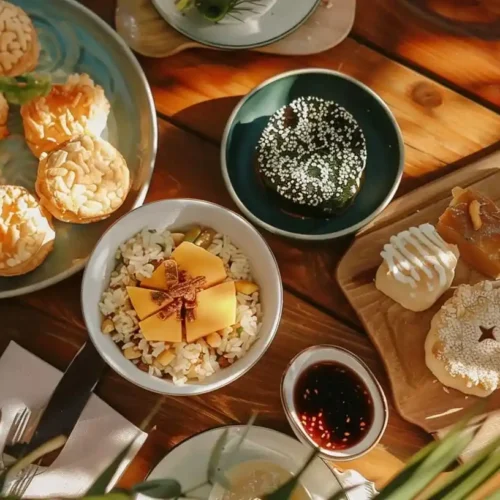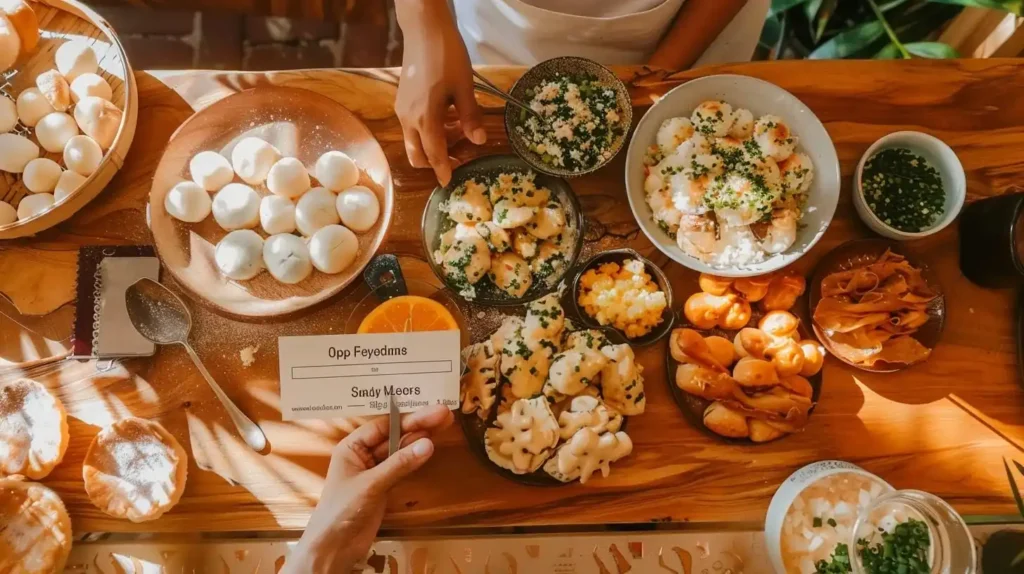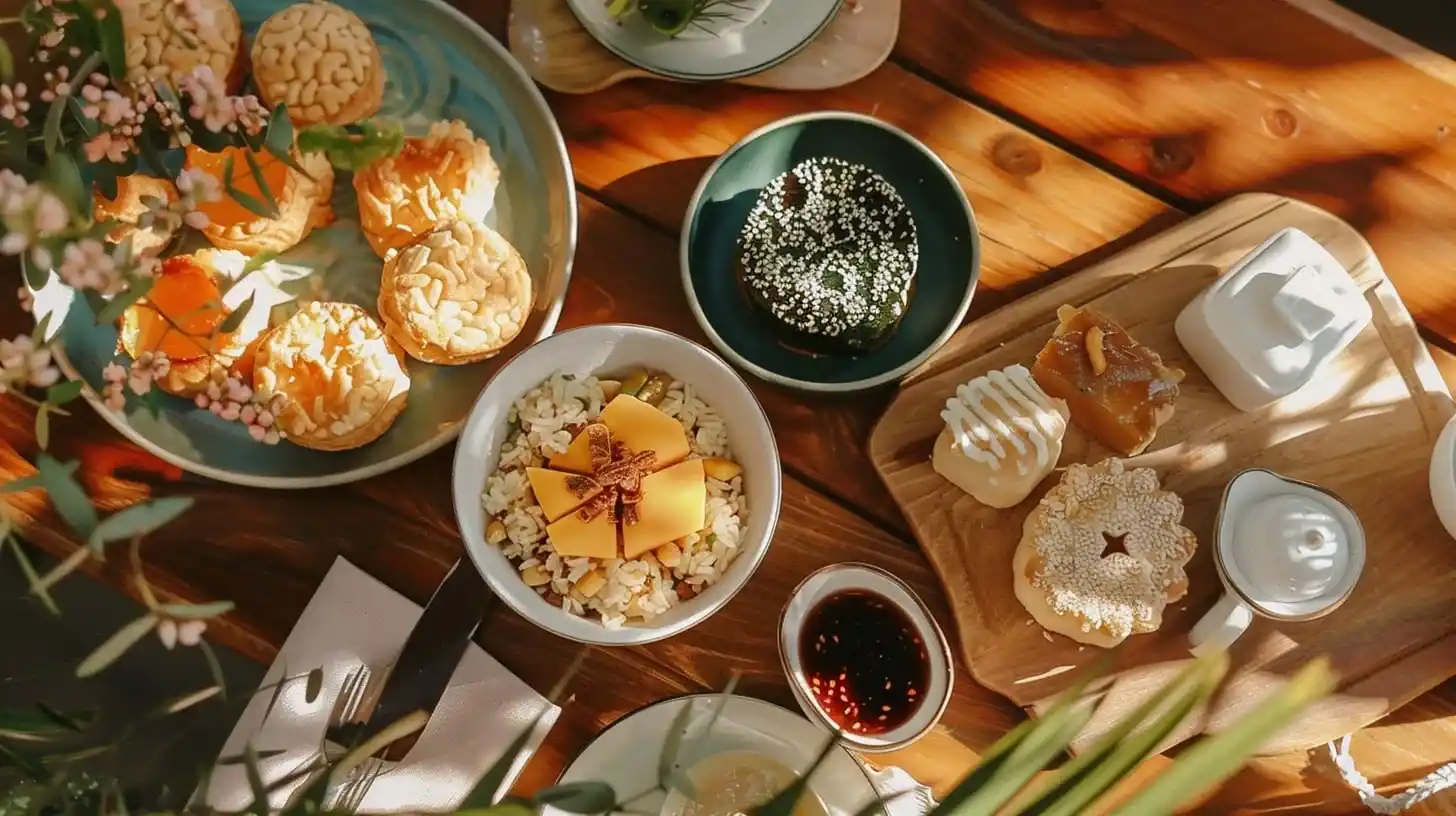When my grandmother first introduced me to mochi during a special family gathering, I was captivated by its delicate sweetness and unique texture. She had learned to make it from her Japanese neighbor decades ago, and watching her hands shape the sticky rice dough brought an entirely new world of desserts into our kitchen. That was my first encounter with Asian desserts, and it sparked a lifelong fascination with sweet treats from across the continent.
As busy parents, we often stick to familiar desserts that we know our children will enjoy. But introducing your family to the diverse flavors of Asian desserts can bring both excitement and cultural appreciation to your table—without requiring hours in the kitchen or specialized equipment.
Table of Contents
Table of Contents

Asian Desserts: 13 Sweet Recipes Across the Continent
Ingredients
- 1 cup sweet rice flour (mochiko)
- 1/4 cup granulated sugar
- 1 cup water
- 1/4 teaspoon vanilla extract (optional)
- Food coloring (optional)
- 1/2 cup potato starch or cornstarch (for dusting)
- Filling options: red bean paste, ice cream, or chocolate pieces
Instructions
- Line a 8×8 inch square pan with parchment paper and dust with potato starch or cornstarch.
- In a microwave-safe bowl, combine the sweet rice flour and sugar. Stir to mix evenly.","Add water and optional vanilla extract (and food coloring if desired). Stir until no lumps remain.
- Cover the bowl with plastic wrap, leaving a small vent.
- Microwave on high for 1 minute. Remove and stir well with a wet spatula.
- Return to microwave and cook for another minute. Stir again.
- Microwave for a final 30 seconds to 1 minute until the mixture turns translucent and has a sticky, gelatinous texture.
- Quickly transfer the hot mochi mixture to the prepared pan. Use a wet spatula to spread it evenly.
- Allow to cool for 30 minutes at room temperature.
- Dust a cutting board with potato starch. Turn the cooled mochi out onto the board.
- Using a plastic knife or cookie cutter dusted with starch, cut into 12 pieces.
- If adding fillings, place a small amount in the center of each piece and gently fold the mochi around it, sealing well.
Notes
Why Asian Desserts Deserve a Place in Your Recipe Collection
- Quick preparation methods make many Asian desserts perfect for busy families looking to try something new
- Unique ingredients like rice flour, red bean paste, and matcha offer nutritional variety beyond typical Western sweets
- Less sugar than many Western counterparts, making them healthier options for children
- Simple techniques that often require fewer steps than complicated cakes or pastries
- Great opportunities for family cooking projects that teach children about different cultures
If you’ve enjoyed our Cozy Breakfast Recipes: Effortless Morning Meals, you’ll find that many of these Asian desserts can double as special breakfast treats as well!
13 Delicious Asian Desserts You Can Make at Home

1. Mochi (Japan)
This soft, chewy rice cake holds a special place in my heart. My grandmother would make it with my mother during holidays, and now I make it with my children. Traditional mochi takes considerable effort, but quick versions using sweet rice flour (mochiko) can be ready in under 30 minutes. The pillowy texture and subtle sweetness make it an effortless introduction to Japanese desserts.
Traditional mochi is often filled with sweet red bean paste, but you can easily adapt it with chocolate, strawberry, or ice cream fillings for children who might be hesitant to try bean paste.
2. Tangyuan (China)
These sweet rice balls in warm syrup remind me of cozy winter evenings. When my daughter was struggling with a cold last winter, I made a simple ginger tangyuan soup that brought comfort the way my grandmother’s chicken soup once did for me. The glutinous rice dough comes together without effort, and kids love helping to shape the small balls.
Tangyuan can be served plain in a light sweet soup or filled with black sesame paste, peanuts, or red bean paste for more complex flavors.
3. Hotteok (Korea)
These sweet Korean pancakes filled with brown sugar, cinnamon, and nuts became an instant hit in our house after a Korean-American neighbor brought them over during the holidays. The dough is remarkably similar to the quick bread recipes I grew up making with my mother, but with a delightful surprise inside.
I love making a batch of hotteok on busy weekend mornings—the dough can be prepared the night before, saving precious morning time while still creating a special breakfast treat.
4. Bingsu (Korea)
This shaved ice dessert saved us during last summer’s heatwave. My children call it “snow dessert,” and we love customizing it with different toppings. The beauty of bingsu is its simplicity—with just a food processor to crush ice, you can create a cooling treat in minutes.
Traditional red bean bingsu is wonderful, but fruit versions with strawberry, mango, or melon make quick, easy alternatives that appeal to children raised on Western flavor profiles.
5. Kheer (India)
This rice pudding connects me to memories of my grandmother’s kitchen—the warm aroma of cardamom and the comfort of creamy textures. Though not identical to her American rice pudding, the familiar elements make it accessible even to picky eaters.
Making kheer in a slow cooker creates an effortless dessert that practically prepares itself while you handle other family responsibilities.
6. Gulab Jamun (India)
These milk-solid dumplings soaked in rose-scented syrup remind me of the donut holes my mother would make, but with an exotic twist. The first time I made them for my family, even my dessert-skeptical husband couldn’t resist having seconds.
While traditional recipes can be complex, simplified versions using milk powder create similar results without the intensive labor.
7. Mango Sticky Rice (Thailand)
This perfect combination of sweet coconut sticky rice with fresh mango slices has become our go-to summer dessert. My children ask for it by name when mangoes are in season, and I love how quickly it comes together after a busy day.
Using a rice cooker for the glutinous rice makes this dish particularly effortless for busy parents.
8. Pandan Cake (Southeast Asia)
The soft, cottony texture and natural green color of this cake fascinated my children the first time we made it together. The pandan extract might seem unfamiliar, but the cake itself uses techniques similar to the chiffon cakes my grandmother taught me to make.
The striking color makes it perfect for holidays or special occasions when you want something visually impressive without complicated decorating techniques.
9. Egg Tarts (Hong Kong/Macau)
These delicate pastries with silky custard filling became a Saturday morning tradition after we discovered how easily they come together with store-bought tart shells. My daughter calls them “sunshine cups” because of their bright yellow centers.
Making the filling takes just minutes, and the results taste like they came from a professional bakery.
10. Boba Tea (Taiwan)
While technically a beverage, bubble tea with its chewy tapioca pearls crosses into dessert territory. My children think of making boba tea as a special cooking project rather than a dessert, which makes it perfect for busy weekends when we want quality time without elaborate preparation.
Pre-made tapioca pearls require just 5 minutes of cooking, and the assembly process is simple enough for children to help.
11. Sesame Balls (China)
These crispy fried treats with sweet fillings remind me of the donuts my grandmother would make, but with the nutritious addition of sesame seeds. The first time I made them, my son declared them “better than donut holes” – high praise from a seven-year-old!
The dough can be prepared ahead and refrigerated, making the final cooking process quick when you need a special treat.
12. Barfi (India)
This milk-based fudge comes together with just a few ingredients and can be flavored countless ways. When my mother visited last spring, we made coconut barfi together—a wonderful bridging of our family’s traditional American fudge recipes with something new and exciting.
The simple cooking process makes it an effortless addition to holiday gift plates or school celebrations.
13. Dango (Japan)
These sweet rice dumplings on skewers delight children with their colorful appearance and chewy texture. My son loves helping to shape and skewer the dango—turning dessert preparation into quality family time without complicated techniques.
The basic recipe requires just rice flour, sugar, and water, making it one of the most accessible Asian desserts for beginners.
Tips for Success with Asian Desserts
When venturing into Asian dessert making, remember that authenticity matters less than enjoyment. My grandmother always said that recipes evolve as they travel, and there’s beauty in adaptations that work for your family. Use ingredients you can easily find, substitute when necessary, and don’t worry if your results don’t look exactly like traditional versions.
Many Asian desserts rely more on texture than sweetness—something Western palates might need time to appreciate. Start with more familiar flavor profiles like mango sticky rice or egg tarts before exploring more exotic options like red bean or black sesame desserts.
Reader Questions
Q: Where can I find ingredients like rice flour or pandan extract?
Most Asian ingredients are now available in the international sections of major grocery stores. For more specialized items, Asian grocery stores or online retailers offer extensive options. I keep rice flour and coconut milk as pantry staples since they’re used in so many quick, easy recipes.
Q: Are Asian desserts healthier than Western desserts?
Many Asian desserts use less sugar and incorporate ingredients like beans, rice, and fruits that add nutritional value. However, “healthy” depends on specific recipes and preparation methods. The desserts featuring fruits, like mango sticky rice, tend to be more nutritious options for busy families looking for better alternatives.
Q: Can my kids help make these desserts?
Absolutely! Many Asian desserts have steps perfect for little helpers. Rolling tangyuan balls, filling mochi, or arranging fresh fruit on bingsu creates wonderful family cooking experiences. My children particularly enjoy shaping dough and adding colorful toppings—skills they’ve learned helping with our Sweet & Savory Treats for Family Mornings.
Q: What’s a good first Asian dessert for beginners?
Start with mango sticky rice or simplified mochi—both use familiar ingredients and techniques similar to Western cooking. If you enjoy our cornbread recipes, you’ll find the dough-based Asian desserts use similar basic techniques.
Asian desserts have brought so much joy and culinary adventure to our family table. I hope they inspire your busy family to explore new flavors together, creating memories just as my grandmother did when she first introduced me to the wonderful world of treats beyond our typical American fare.
With warmth, Sophia
for more recipes follow me in facebook and pinterest and twitter





